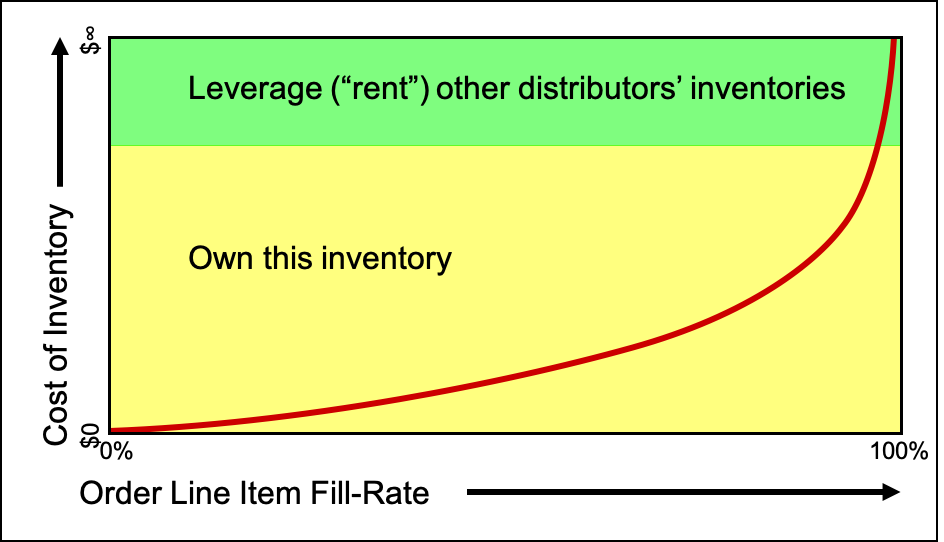Categories: Inventory Management
By Mark Tomalonis
Principal, WarehouseTWO, LLC
 What does it cost to own inventory? Chances are, a lot more than you think. To make matters worse, owning inventory has recurring costs, every year. Rather than owning all of the inventory that your end-customers might need from you, consider "renting" some of it. For the cost of a cup of coffee per day, "rent" millions of dollars of inventory. Here's how...
What does it cost to own inventory? Chances are, a lot more than you think. To make matters worse, owning inventory has recurring costs, every year. Rather than owning all of the inventory that your end-customers might need from you, consider "renting" some of it. For the cost of a cup of coffee per day, "rent" millions of dollars of inventory. Here's how...
What does it cost to own $1,000,000 of inventory?
Owning inventory costs your company something. For example, if you bought that inventory with cash, the minimal cost is the opportunity cost of having invested that money into something else, such as the stock market. And if you borrowed money to buy the inventory, then the minimal cost is the interest rate on the loan or line of credit.
In reality, the total cost of owning inventory, or "carrying cost", greatly exceeds the opportunity cost of cash or the interest on borrowed money. There are many other contributors to total "carrying cost", including:
A conservative "carrying cost" is 20% of the value of the inventory. Per year. Thus, conservatively, it costs $200,000 every year to own $1,000,000 of inventory. (For a detailed analysis of what your company's true inventory carrying costs are, contact my favorite inventory guru, Jon Schreibfeder of Effective Inventory Management, Inc.)
What does it cost to own enough inventory to fulfill, from stock, every order that your end-customers might give you?
Consider your company's "fill rate", the percentage of non-scheduled order line items that your company receives that can be fulfilled on the day of order receipt from your available inventory. The relationship between fill rate and inventory required is illustrated in the graph below. While the relationship may start out linear, it becomes exponential as a 100% fill rate is approached. A fill rate of 100% means that you have in stock whatever your customers might want today, including items that your company has never sold before. That is, for a 100% fill rate, your company would have to have everything in stock. "Everything in stock" can be achieved only by having infinite inventory. What is the cost of having infinite inventory? $infinity ($∞).

Of course, no one owns an infinite amount of inventory. But there is a simple work-around to increase order fill-rates without owning more inventory: "rent" inventory.
If it costs $200,000 per year to own $1,000,000 of inventory, and if it costs an infinite amount of money to have have whatever your customers want, whenever they want it, what does it cost to "rent" millions of dollars of inventory? About the cost of a cup of coffee per day.*
True confession: I am not really suggesting that you actually rent inventory. Instead, I am suggesting that you leverage finished-goods inventories owned by peer wholesaler-distributors inventories in your industry, via the practice of "inventory-sharing" (also known as "inventory-pooling"). By collaborating with your suppliers and their other authorized distributors, you can gain access to millions of dollars of finished goods inventory, without actually owning it. Buy from other distributors only what you need to fill unanticipated non-stock back-orders. Your end-customers will still get what they want from you within a day or two, without you having to invest in a lot of speculative or "safety stock" inventory. Participating in a formal inventory-sharing service typically incurs a monthly subcription as low as a few dollars per day. A lot like a cup of coffee per day.*
The illustration below suggest which portion of your company's order demands should be fulfilled by inventory that your company owns and which portion might be handled by inventory available from peer wholesaler-distributors.

If you think that depending on other distributors' inventories to server your end-customers is an unrealistic idea, consider what Amazon does.
More inventory for your end-customers, without having to own more inventory. That is the power of "inventory-sharing".
*equivalent to a Level 2 membership at WarehouseTWO.
About the Author After a successful career in sales and operations management in the wholesale-distribution industry, Mark Tomalonis is now principal of WarehouseTWO, LLC. He amuses himself by writing articles, such as this one, to help wholesaler-distributors execute their operations better. Mark’s articles and tips are published in WarehouseTWO’s monthly e-newsletters. Click here to subscribe.
After a successful career in sales and operations management in the wholesale-distribution industry, Mark Tomalonis is now principal of WarehouseTWO, LLC. He amuses himself by writing articles, such as this one, to help wholesaler-distributors execute their operations better. Mark’s articles and tips are published in WarehouseTWO’s monthly e-newsletters. Click here to subscribe.
About WarehouseTWO
WarehouseTWO, LLC is an independent “inventory-sharing” service created exclusively for durable goods manufacturers and their authorized distributors, and for any group of durable goods “peer” wholesaler-distributors, such as members of a buying/marketing group or cooperative. To learn how inventory-sharing with WarehouseTWO can help your business, visit the WarehouseTWO website, or email info@warehousetwo.com.